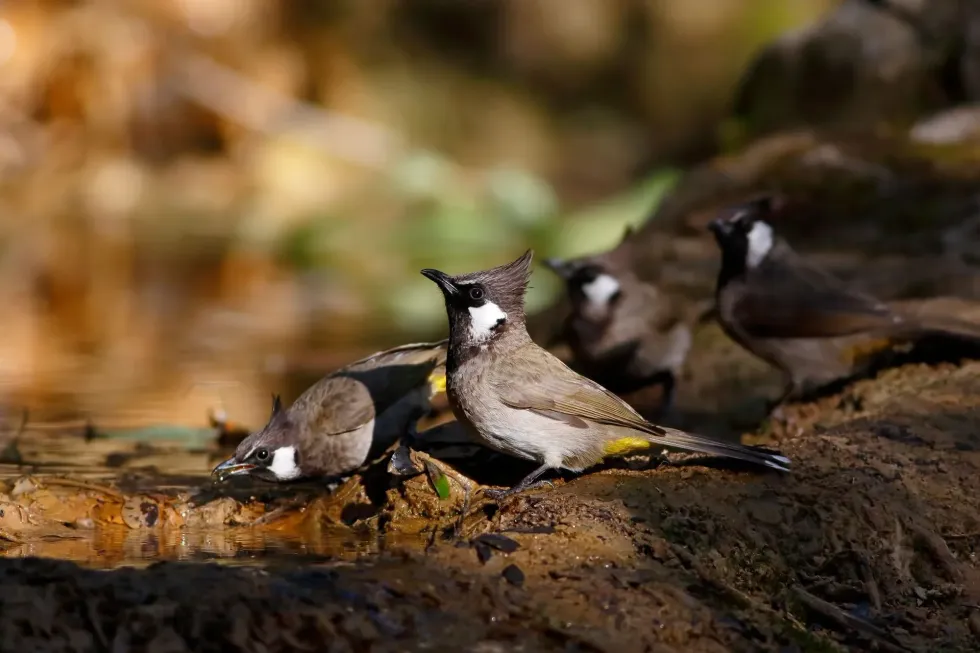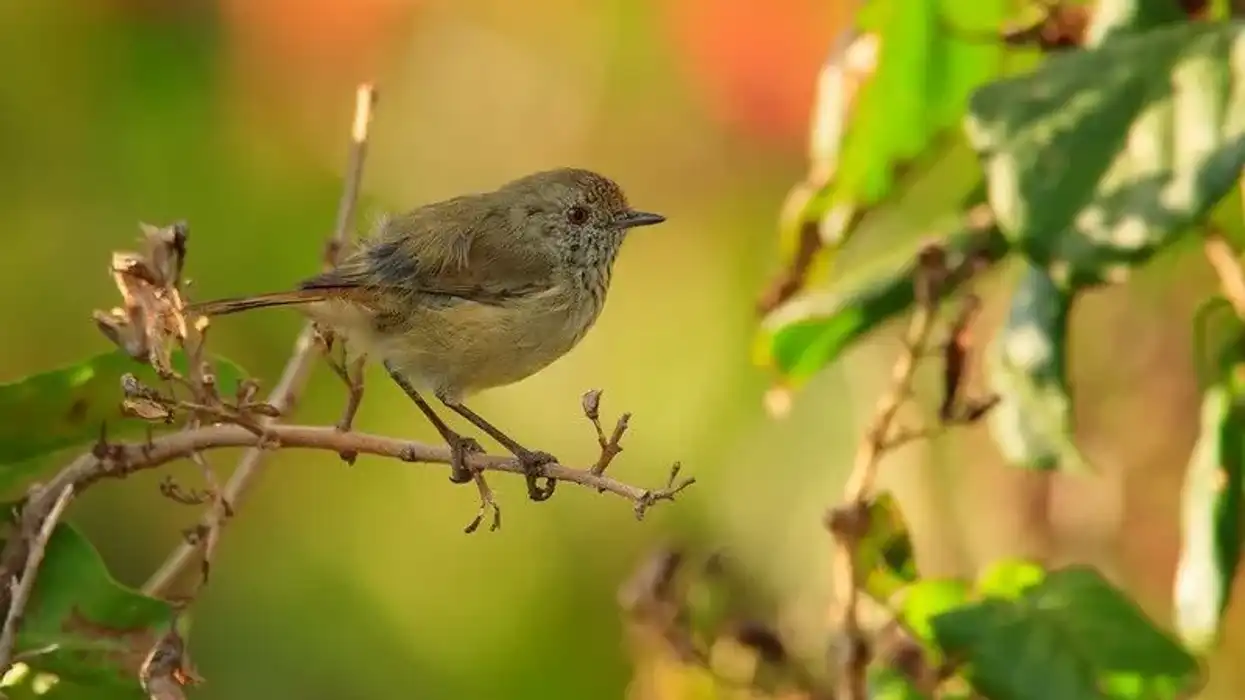Himalayan bulbul birds are extremely common and can be found in regions of Himalayan foothills and in countries like India, Nepal, Pakistan. Other regions where they are commonly found are mangrove and subtropical forests. Interestingly, these birds are fearless and human friendly and can be more than often seen in parks and gardens of towns and cities.
The bulbul feeds on insects, small invertebrates, berries, seeds, nuts, fruits. Therefore these cute birds can be found in regions having fruit trees. They prefer to build their nest in bushes or on lower branches of trees with twigs, stems, grass, leaves, lichens, and mosses.
There they lay a clutch of two to five eggs which is incubated for a length of 12 days by the female. After this, the chicks are ready to leave their nest.
Bulbuls breed anytime between April-July. The peak month being May. It is in the month of May that maximum nests are built and eggs are laid.
The babies have pale feathers with brown heads, unlike the elders who have black heads. The bill and legs are also black in color. The bird is otherwise grayish-brown with a white patch around the eyes. The throat is blackish.
Wings also have white spots on them. The tail is black-brown and the feathers under the tail are a bright yellow. The birds found specifically around mountains have a mohawk on their head.
If you like what you read, do check out blue jay and Amazon parrot.
Himalayan Bulbul Interesting Facts
What type of animal is a Himalayan bulbul?
The Himalayan bulbul (Pycnonotus leucogenys) belongs to Pycnonotidae family. They are small white-cheeked bulbul that are residents of the Himalayan foothills.
What class of animal does a Himalayan bulbul belong to?
Himalayan bulbul belongs to the class Aves, that is birds.
How many Himalayan bulbuls are there in the world?
The exact number of Himalayan bulbul birds is not documented, but from IUCN Red List we get the information that their population trend is increasing.
Where does a Himalayan bulbul live?
Himalayan bulbul birds belonging to the Pycnonotidae family and Pycnonotus genus are extremely common birds that can be found not only in mangroves, subtropical forests, valleys, and woods but can also be seen in towns and cities.
These birds feed on insects, berries, fruits, seeds, buds, and nectar and can therefore survive in any region that has flowering and fruit-bearing trees.
They can also be seen in areas with an elevated region that ranges from 985-6562 ft (300-2000 m) as long as there is a source of seeds buds and nectar.
What is a Himalayan bulbul's habitat?
This species of birds can be found in the foothills of the Himalayas and northwestern India. Bulbul birds are also common in India, southern Iran, Afghanistan, Bhutan, Nepal, Pakistan, and Tajikistan.
Though the name suggests that the species are a resident of the Himalayan region yet the species can be found in coastal regions, subtropical forests, mangroves, towns, cities, etc.
They are an extremely familiar bird that is not much affected by deforestation and can easily be found in areas close to or near human habitats. They can be seen in elevation starting from 985-6562 ft (300-2000 m) if fruit trees are present.
Who do Himalayan bulbuls live with?
The Himalayan bulbul (Pycnonotus leucogenys) bird that feeds on insects, fruits, berries, seeds prefers living in bushes than on trees and is found either in small groups or in pairs.
How long does a Himalayan bulbul live?
The lifespan of a Himalayan bulbul bird, genus Pycnonotus, is approximately 11 years.
How do they reproduce?
Himalayan bulbul birds build their nests during the months of April-July which is their breeding season. While the month of May is the peak breeding month.
The thin and shallow nests which look like cups are built in bushes or on lower branches of trees that are 19.7-118 in (50 cm- 300 cm) above the ground.
Their nests are built with twigs, grass, leaves and are lined with lichens and moss where they lay a clutch of two to five eggs that they incubate for 12 days, after which the chicks leave the nest.
This is mainly done by the Himalayan bulbul female of the species. While the responsibility of feeding the chicks belongs to both the parents.
What is their conservation status?
IUCN Red List marks Himalayan bulbul bird as Least Concern. The population of the Himalayan bulbul is increasing and there is no chance of it going Extinct in the near future. Yet there are a few natural predators of Himalayan bulbul like, magpies, ravens, hawks, eagles, mongoose, monitor lizards, snakes, and wildcats.
Himalayan Bulbul Fun Facts
What do Himalayan bulbuls look like?
Himalayan bulbuls, a common resident of India, are grayish-brown in color, with white cheeks and completely black hood, bill, and legs. The ones that particularly live in the mountainous areas have a mohawk that is missing from the ones that live on plains.
The undertail is a bright yellow, while the underpart is white. Its throat and head are black with white patches on the throat spreading below the eyes and onto the cheeks.
Feathers on the upper areas are dull gray, while the wings are darker gray and the tail is black-brown with white spots with a sunshine yellow plumage, peeping from the rear end.
Bulbuls have a long tail. The breast of the bird is a soft dusky-brown.
Iris of these bulbuls is red-brown with a thin yellow ring encircling the outside area of the eyes. The Himalayan bulbul male and female look similar.
The immature or juvenile birds are characterized by pale plumage and a pale brown head.

How cute are they?
Himalayan bulbul, a resident of India and a few neighboring countries, though not very brightly colored are tiny birds with angry-looking faces, a mohawk, and a melodious song like whistles, making them appear quite cute.
How do they communicate?
Himalayan bulbuls (Pycnonotus leucogenys) are melodious songbirds that communicate with each other through various sounds like, 'oo-toodle-oo', 'plee...plee...plee...', chups, squeaks, gurgling warbles, raspings. They also have a cry of alarm which is sharp and throaty.
How big is a Himalayan bulbul?
Himalayan bulbul also referred to as white-cheeked bulbul is a tiny bird whose weight varies between 1.19-1.34 oz (34-38 g) and has a length of 7.08 in (18 cm). The wingspan of a Himalayan bulbul (Pycnonotus leucogenys) is 10- 11 in (25-28 cm).
Birds of similar species are almost the same in size. The red-whiskered bulbul (Pycnonotus jocosus) with a length of 8-8.7 in (20-22 cm) and weight of 0.81-1.48 oz (23-42 g) is even smaller than Himalayan bulbul.
How fast can a Himalayan bulbul fly?
The speed of the Himalayan bulbuls (Pycnonotus leucogenys) belonging to the Pycnonotidae family is not documented, but they are known to fly really fast and have a wingspan of 10- 11 in (25-28 cm).
How much does a Himalayan bulbul weigh?
Himalayan white-cheeked bulbul, which lives mainly in India, is a tiny songbird that feeds mainly on fruit seeds, buds, and nectar and the weight range is between 1.19-1.34 oz (34-38 g).
What are the male and female names of the species?
The species of Himalayan bulbul does not have any specific or unique names for its male and female birds.
What would you call a baby Himalayan bulbul?
A baby Himalayan bulbul (Pycnonotus leucogenys) is simply referred to as a chick.
What do they eat?
A Himalayan black bulbul diet consists of insects and small invertebrates, like lizards. They also feed on nectar, fruits, seeds, buds, and berries. These bulbul birds catch flying insects in the air and feed on them. Other than this bulbul are fearless birds who can often be seen entering households to nibble on pieces of bread.
Are they poisonous?
The Himalayan bulbul has no record of being poisonous.
Would they make a good pet?
Bulbuls are tame birds, human friendly in nature. They are fearless and are comfortable in the household atmosphere and can easily be a resident of your home, making them a good pet.
Did you know...
Bulbuls have prominent bristles throughout the length of the base of the top mandible.
A bulbul signifies longevity and a long and happy marriage.
Various birds such as Himalayan snowcocks, Himalayan quails, Himalayan monals, western tragopans, Blyth's tragopans, Kashmir flycatchers, Himalayan golden eagles, Himalayan griffon vultures, etc., live in the Himalayas.
Himalayan bulbul is the national bird of Bahrain.
These birds migrate seasonally or altitudinally.
The word 'bulbul' means 'nightingale' in English. However, bulbuls refer to passerine birds in English.
Do bulbuls mate for life?
These species are monogamous. They mate for life. A bulbul preens their feathers to impress the opponent sex. After forming a pair the bulbul sings a duet.
Are Himalayan bulbuls Endangered?
Himalayan bulbul (Pycnonotus leucogenys) is not at all Endangered. In fact, its population is increasing. This is so because other than their natural habitat, these species are equally adaptable to life in cities. Himalayan bulbul can easily co-exist with humans and are friendly in nature.
Here at Kidadl, we have carefully created lots of interesting family-friendly animal facts for everyone to discover! For more relatable content, check out these American pipit facts and canyon wren facts pages.
You can even occupy yourself at home by coloring in one of our free printable bird coloring pages.
Second image: Creepanta










